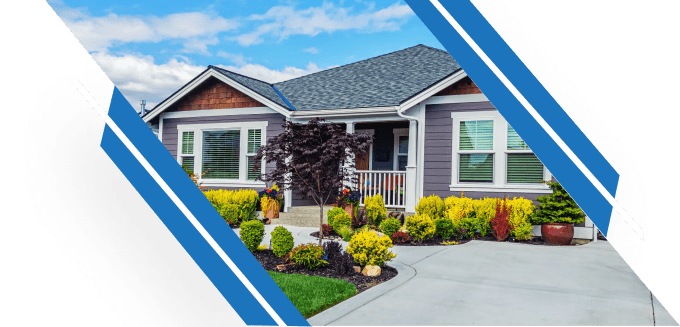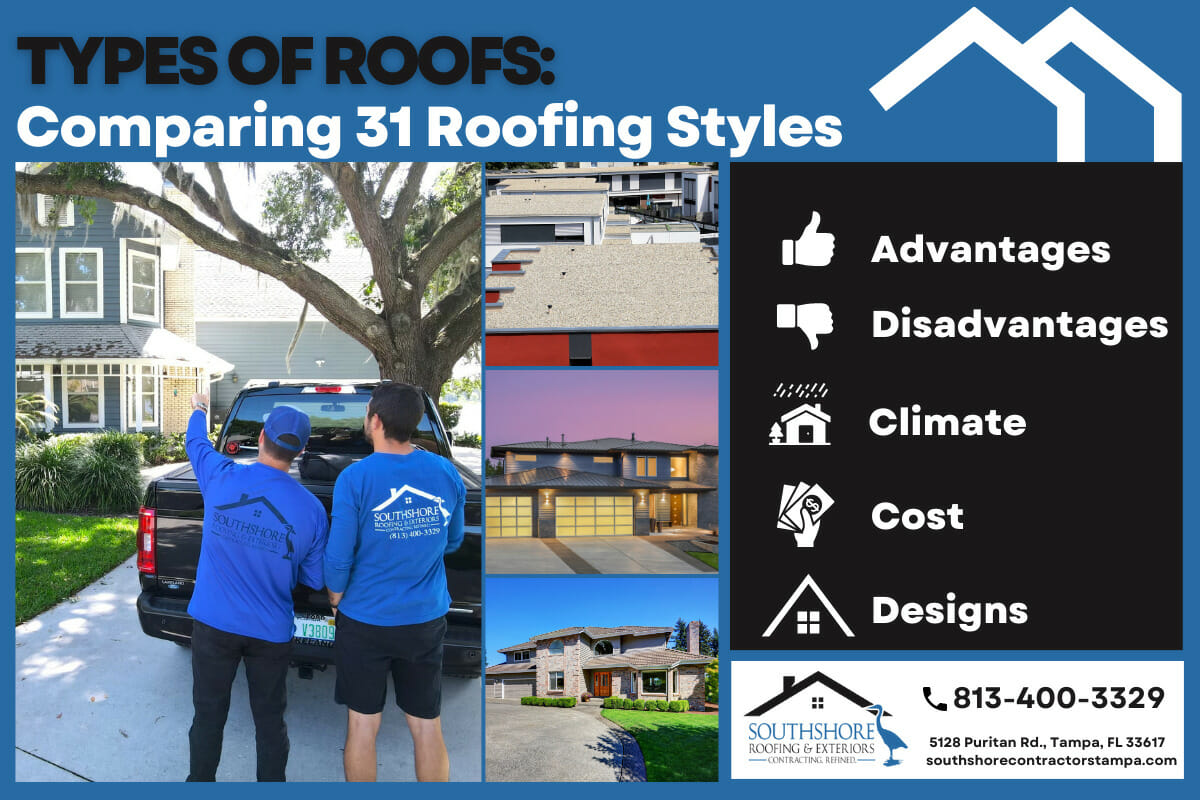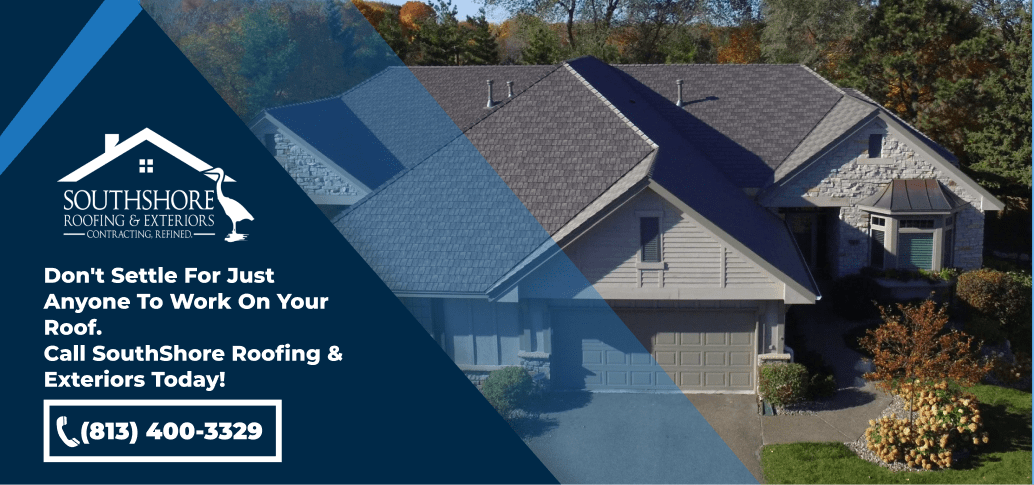Have you ever found yourself gazing at different roofs and asking, ‘What kind of roof is that? Could that work for my home?’ Picking the perfect roof type involves more than just choosing the best roofing material. You need to consider style, climate suitability, and cost. Each roof type comes with its own unique pros and cons, so it’s critical to pick the one that best fits your needs. In this guide, we’re going to compare different roof types, examine their styles, assess their suitability for various climates, and break down their costs.
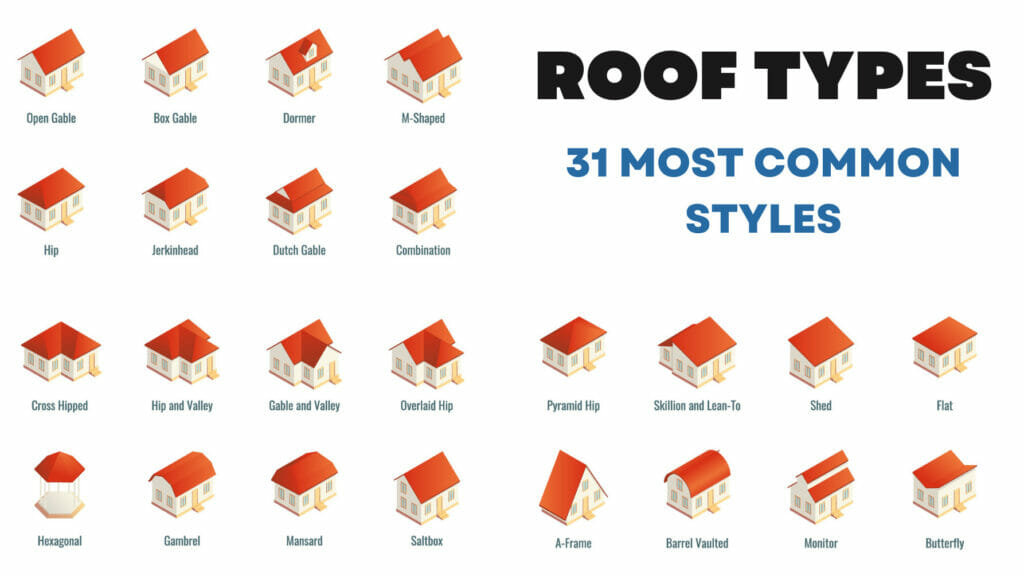
👉🏼Five Categories of Roofing Styles
In our exploration of roofing options, we’ll categorize them into five distinct groups: basic, gable variations, complex, unique, and special. This classification will streamline our understanding of the various roofing choices available.
| Category | Roof Types |
|---|---|
| Basic Roof Types | Gable Roof, Hip Roof, Flat Roof, Shed Roof, A-Frame Roof, Lean-To Roof |
| Gable Roof Variations | Dutch Roof, Jerkinhead Roof, Open Gable Roof, Box Gable Roof, M-Shaped Roof, Cross Gabled Roof |
| Unique Roof Types | Curved Roof, Dome Roof, Octagon Roof, Hexagon Roof, Round Roof, Cone Roof, Polynesian Roof |
| Complex Roof Types | Mansard Roof, Bonnet Roof, Gambrel Roof, Saltbox Roof, Pyramid Roof, Butterfly Roof, Sawtooth Roof, Cross Hipped Roof, Hip and Valley Roof |
| Special Roof Types | Flat Seam Metal Roof, Dormer Roof |
👉🏼Basic Roof Types:
1. Gable Roof
Also known as a pitched or peaked roof, gable roofs are among the most popular roof styles in the U.S., known for their triangular shape.
- Climate Suitability: Gable roofs perform well in areas with rain, snow, and ice. However, they are not ideal for regions prone to high winds or hurricanes.
- Cost: Gable roofs typically cost between $6 and $9 per square foot, depending on the materials used.
- Materials: Asphalt shingles, wood shingles or shakes, metal shingles, and slate are common materials used for gable roofs.
-
Pros and Cons:
Pros Cons Simple to build May require more frequent repairs Promotes water runoff Wind can cause materials to peel off Allows more space for attic or vaulted ceiling Common design, lacking uniqueness Suitable for most homes
2. Hip Roof
Featuring four equal-length slopes that meet at a central ridge, the hip roof is both attractive and robust.
- Climate Suitability: Hip roofs excel in areas with high winds, hurricanes, rain, ice, or snow.
- Cost: The cost ranges from $8 to $12 per square foot.
- Materials: Common materials include asphalt shingles, standing seam metal, metal shingles, and clay or concrete tiles.
- Pros and Cons:
Pros Cons High curb appeal More complex and expensive to build Increased structural integrity Prone to leaks, especially at the ridge Excellent drainage Provides less attic space Suitable for windy climates Requires more maintenance
3. Flat Roof
As the name suggests, flat roofs are flat or have a very slight pitch. They are common on commercial buildings and modern residential homes.
- Climate Suitability: Flat roofs are ideal for arid climates with low rainfall and snowfall. They can struggle in wet climates and places with heavy snowfall.
- Cost: A flat roof generally costs between $5 and $10 per square foot.
- Materials: EPDM (rubber), TPO, PVC, modified bitumen, roll roofing, and spray-on roof coatings are commonly used materials for flat roofs.
- Pros and Cons:
Pros Cons Inexpensive to build High maintenance Space for HVAC, solar panels, etc. Poor drainage can lead to water damage Easy to inspect and maintain Not suitable for heavy snowfall
4. Shed Roof
Also known as a lean-to roof or a skillion roof, a shed roof is a single-sloped roof, typically attached to a taller wall.
- Climate Suitability: Shed roofs are suitable for areas with moderate climates.
- Cost: The cost of a shed roof ranges from $4 to $6 per square foot.
- Materials: Materials often used for shed roofs include asphalt shingles, wood shingles or shakes, metal, and slate.
- Pros and Cons:
| Pros | Cons |
|---|---|
| Easy and inexpensive to build | Limited durability in high wind areas |
| Ideal for small structures | Limited interior space |
5. Mansard Roof
Mansard roofs have a flat top and steep sides. Featuring a double slope on all four sides, the lower slope being steeper than the upper one, a mansard roof, also known as a French roof, offers increased living space.
- Climate Suitability: Mansard roofs are not ideal for regions with heavy snowfall as the design doesn’t encourage natural snow runoff. They perform well in temperate climates.
- Cost: The cost of a mansard roof ranges from $10 to $20 per square foot.
- Materials: Materials often used include metal, slate, asphalt shingles, and wood shingles or shakes.
- Pros and Cons:
| Pros | Cons |
|---|---|
| Versatile aesthetic | Expensive due to complex design |
| Additional living or storage space | Lower slopes can suffer weather damage |
| Allows for future home expansion | Poorly suited for heavy snowfall |
Related: What Is A Mansard Roof, And Should You Install It?
6. Bonnet Roof
Often referred to as the “reverse mansard,” a bonnet roof has double slopes on all four sides, with the lower slope protruding further. Bonnet roofs are a variation of hip roofs.
- Climate Suitability: Bonnet roofs perform well in regions prone to rain, wind, ice, or snow.
- Cost: Bonnet roofs can range from $15,000 to $30,000, depending on the materials and complexity of the design.
- Materials: While metal is often preferred for bonnet roofs, they can also be constructed using shingles.
- Pros and Cons:
Pros Cons Provides excellent shade Requires careful waterproofing Ideal for a porch or balcony Uncommon design Handles heavy wind, rain, or snow well Complex construction
7. Lean-To Roof
Lean-To roofs, also known as shed roofs or pent roofs, feature a single, flat slope. This simple roof style is not only affordable but also provides excellent drainage and is ideal for smaller structures like sheds, porches, or home additions.
- Climate Suitability: Lean-To roofs are suitable for areas with moderate climate conditions.
- Cost: The cost of a Lean-To roof ranges from $4 to $6 per square foot.
- Materials: Asphalt shingles, wood shingles or shakes, metal, and slate are common materials used for Lean-To roofs.
- This concludes the roof type overviews based on the provided content. If you have additional roof types or need more information, feel free to ask.
- Pros and Cons:
| Pros | Cons |
|---|---|
| Easy and inexpensive to build | Limited durability in high wind areas |
| Ideal for small structures | Limited interior space |
| Allows for high ceilings and natural light |
8. Gambrel Roof
Resembling a barn roof, a gambrel roof has two slopes on each side, with the lower slope being significantly steeper.
- Climate Suitability: These roofs are not suited for areas with heavy snow or high winds.
- Cost: A gambrel roof typically costs between $16,000 and $28,000.
- Materials: Gambrel roofs can be built with a variety of materials including asphalt shingles, wood shingles or shakes, slate, metal, and clay or concrete tiles.
- Pros and Cons
| Pros | Cons |
|---|---|
| Provides ample attic space | Not ideal for heavy wind, rain, or snow |
| Easy and affordable to build | |
| Eye-catching, distinctive design |
Related: Top 5 Gambrel Roof Design Ideas For Your Home
👉🏼Gable Roof Variations:
9. Dutch Roof
Also known as a Dutch gable roof, this style blends a hip roof with small gables at either end. It provides increased attic space and allows for more natural light.
- Climate Suitability: Dutch roofs are well-suited to areas prone to rain, ice, snow, or wind.
- Cost: Dutch roofs typically range from $8 to $12 per square foot
- Materials: Materials used often include asphalt shingles, wood shingles or shakes, slate, metal shingles, standing seam metal, and clay or concrete tiles.
- Pros and Cons
Pros Cons Increased attic and top floor space Complex construction Increased natural light Expensive Improved ventilation High maintenance Excellent drainage and gutter systems Increased risk of leaks
10. Jerkinhead Roof
Also known as a clipped gable or half-hip roof, jerkinhead roofs combine the strengths of gable and hip roofs to provide a sturdy, all-weather roof.
- Climate Suitability: Ideal for areas prone to high winds, hurricanes, ice, rain, and snow.
- Cost: The cost ranges from $10 to $15 per square foot.
- Materials: Common materials used for jerkinhead roofs include asphalt shingles, standing seam metal, slate, clay or concrete tiles, and wood shingles or shakes.
- Pros and Cons:
Pros Cons Increased structural integrity Expensive Historic curb appeal and unique design Complex repairs Less prone to leaks than traditional hip roofs High maintenance Suitable for windy climates
11. Open Gable Roof
Open gable roofs are similar to traditional gable roofs but with an open design that allows for increased ventilation and natural light. This style is often seen in tropical regions and beach houses.
- Climate Suitability: Open gable roofs are ideal for tropical climates and areas with moderate rainfall.
- Cost: The cost of an open gable roof ranges from $6 to $9 per square foot.
- Materials: Asphalt shingles, wood shingles or shakes, metal, and slate are common materials used for open gable roofs.
- Pros and Cons:
| Pros | Cons |
|---|---|
| Increased ventilation | Not suitable for areas with high winds or heavy snowfall |
| Increased natural light | Potential for leaks at the open ends |
| Simple to construct |
12. Box Gable Roof
Box gable roofs are a variation of the traditional gable roof with a box-like extension at the end. This style is often seen in residential homes and provides additional interior space.
- Climate Suitability: Box gable roofs are suitable for areas with moderate rainfall and wind conditions.
- Cost: The cost of a box gable roof ranges from $6 to $9 per square foot.
- Materials: Asphalt shingles, wood shingles or shakes, metal, and slate are common materials used for box gable roofs.
- Pros and Cons:
| Pros | Cons |
|---|---|
| Increased interior space | Potential for leaks at the box ends |
| Simple to construct | Not suitable for areas with high winds or heavy snowfall |
13. Cross Gabled Roof
Cross gabled roofs are similar to gabled roofs but with two sections that cross. This style is often seen in homes with complex layouts or additional wings.
- Climate Suitability: Cross gabled roofs are suitable for areas with heavy rainfall and moderate wind conditions.
- Cost: The cost of a cross gabled roof ranges from $6 to $9 per square foot.
- Materials: Asphalt shingles, wood shingles or shakes, metal, and slate are common materials used for cross gabled roofs.
- Pros and Cons:
| Pros | Cons |
|---|---|
| Excellent water drainage | Complex to build |
| Ample interior space | Potential for leaks at the valleys |
👉🏼Unique Roof Types:
14. Curved Roof
Curved roofs are an emblem of modern architectural design, featuring a curved arch at either end. They’re not only aesthetically pleasing but also offer superior weather resistance. However, their unique design requires specialized labor to install, making them a pricier option.
- Climate Suitability: Curved roofs are versatile and suitable for all types of environments and weather conditions.
- Cost: Installing a curved roof can cost anywhere between $8 and $20 per square foot.
- Materials: Metal is typically the go-to material for curved roofs due to its flexibility and durability.
- Pros and Cons:
| Pros | Cons |
|---|---|
| Modern aesthetics | Can be expensive |
| Unique and customizable | Requires specialized labor |
| Low-maintenance | Most suited to commercial properties |
| Works in all climates | |
| Eco-friendly |
15. Dome Roof
A dome roof is a rare and distinctive roofing style, fashioned in the shape of a rounded, half-sphere. These are less commonly seen in residential areas but can be an excellent choice due to their durability and energy efficiency.
- Climate Suitability: Due to their superior wind resistance, dome roofs are suitable for all climate conditions.
- Cost: Dome roofs range in cost from $10 to $25 per square foot.
- Materials: Common materials used for dome roofs include concrete, metal, and glass.
- Pros and Cons:
| Pros | Cons |
|---|---|
| Unique and aesthetically pleasing | Complex and expensive to build |
| Excellent durability and wind resistance | Limited interior space |
| Energy-efficient |
16. Octagon Roof
Octagon roofs, featuring an eight-sided design, are often used on smaller structures such as gazebos or garden sheds, adding a distinctive look to the building.
- Climate Suitability: These roofs are suitable for areas with moderate to high wind conditions.
- Cost: An octagon roof typically costs between $10 and $20 per square foot.
- Materials: Wood, asphalt shingles, and metal are preferred materials for octagon roofs.
- Pros and Cons:
| Pros | Cons |
|---|---|
| Unique design | Complex to build |
| Good wind resistance | Limited interior space |
17. Hexagon Roof
Hexagon roofs are another unique architectural design, characterized by their six-sided shape. While offering a distinctive look, they can be more complex to build than traditional roofs.
- Climate Suitability: Hexagon roofs are suitable for areas with moderate to high wind conditions.
- Cost: The cost of a hexagon roof ranges from $10 to $20 per square foot.
- Materials: Wood, asphalt shingles, and metal are common materials used for hexagon roofs.
- Pros and Cons:
| Pros | Cons |
|---|---|
| Unique design | Complex to build |
| Good wind resistance | Limited interior space |
18. Round Roof
Round roofs, characterized by their curved shape, are not commonly seen in residential areas. Despite their unique style, they offer excellent durability and energy efficiency.
- Climate Suitability: Round roofs are suitable for all climate conditions due to their excellent wind resistance.
- Cost: The cost of a round roof ranges from $10 to $20 per square foot.
- Materials: Concrete, metal, and glass are common materials used for round roofs.
- Pros and Cons:
| Pros | Cons |
|---|---|
| Unique and aesthetically pleasing | Complex and expensive to build |
| Excellent durability and wind resistance | Limited interior space |
| Energy-efficient |
19. Cone Roof
Cone roofs, often found in architectural styles like Victorian or Tudor, are characterized by their conical shape and are typically used on turrets.
- Climate Suitability: Cone roofs are suitable for areas with moderate to high wind conditions.
- Cost: The cost of a cone roof ranges from $10 to $20 per square foot.
- Materials: Wood, asphalt shingles, and metal are common materials used for cone roofs.
- Pros and Cons:
| Pros | Cons |
|---|---|
| Unique and aesthetically pleasing | Complex and expensive to build |
| Good wind resistance | Limited interior space |
20. Polynesian Roof
Polynesian roofs, also known as Hawaiian roofs, are characterized by their steep pitch and overhanging eaves. This style is often seen in tropical regions and provides excellent ventilation and protection from the sun.
- Climate Suitability: Polynesian roofs are ideal for tropical climates.
- Cost: The cost of a Polynesian roof ranges from $8 to $12 per square foot.
- Materials: Wood shingles or shakes, metal, and thatch are common materials used for Polynesian roofs.
- Pros and Cons:
| Pros | Cons |
|---|---|
| Excellent ventilation | Complex to construct |
| Protection from the sun | Not suitable for areas with heavy snowfall |
| Unique aesthetics |
👉🏼Complex Roof Types:
21. Saltbox Roof
Featuring an asymmetrical design, a saltbox roof has one side that’s a lean-to or a shed-style gable, and another side that’s flat or has a low slope. Saltbox roofs originated in New England in the 17th century.
- Climate Suitability: Saltbox roofs are perfect for northern climates that experience rain, snow, ice, high winds, or hurricanes.
- Cost: The cost of a saltbox roof typically ranges from $20,000 to $36,000.
- Materials: Saltbox roofs can be constructed with various materials such as asphalt shingles, wood shingles or shakes, slate, and clay or concrete tiles.
- Pros and Cons
Pros Cons Handles strong winds well More expensive to build Easy to maintain in winter Creates awkward interior spaces
Related: Exploring the Unique Design and Functionality of Saltbox Roofs
22. Pyramid Roof
A pyramid roof is exactly as it sounds – a roof in the shape of a pyramid. This style is typically found on small structures such as cabins and bungalows.
- Climate Suitability: Pyramid roofs are best suited to regions prone to high winds, hurricanes, or heavy rain. They can also withstand snowy conditions due to their steep slopes.
- Cost: The construction of a pyramid roof ranges from $10 to $14 per square foot, given its complexity.
- Materials: The commonly used materials for pyramid roofs include asphalt shingles, wood shingles or shakes, metal shingles, slate, and clay or concrete tiles.
- Pros and Cons:
| Pros | Cons |
|---|---|
| High structural integrity | Difficult and costly to construct |
| Excellent for wind resistance | Limited interior space |
| Low maintenance |
22. Butterfly Roof
Butterfly roofs, with their unique inverted gable design, are a favorite for modern aesthetics. Butterfly roofs are popular in modern architecture. They are well-suited for large windows, solar panels, and rainwater catchment systems but can struggle in regions with heavy snow or rainfall.
- Climate Suitability: Butterfly roofs are ideal for arid desert climates and areas with high winds but struggle with heavy snow or rainfall.
- Cost: The cost of a butterfly roof ranges from $7,000 to $18,000.
- Materials: Waterproof materials, including rubber roofing (EPDM, TPO, PVC), are commonly used for butterfly roofs.
- Pros and Cons:
| Pros | Cons |
|---|---|
| Strong wind resistance | Complex and costly to build and maintain |
| Effective water drainage | Not suitable for heavy rain and snow |
| Easy solar panel installation | |
| Collects rainwater for use |
24. Sawtooth Roof
Sawtooth roofs, resembling serrated blades with multiple slopes at the same angle, are appreciated for their modern design. They allow for high ceilings, lofted living space, and larger windows for increased natural light.
- Climate Suitability: Sawtooth roofs struggle in areas with heavy snow or rainfall.
- Cost: The cost of a sawtooth roof ranges from $12 to $30 per square foot.
- Materials: Wood shingles and shakes, metal shingles, and reinforced concrete are common materials for sawtooth roofs.
- Pros and Cons:
| Pros | Cons |
|---|---|
| Ideal for radiant heating and solar panels | Expensive |
| Increased loft and attic space | Complex construction |
| High ceilings | Prone to leaks and water damage |
| Increased natural light | High-maintenance |
25. A-Frame Roof
A-Frame roofs, named for their steep, triangular shape resembling the letter ‘A’, are common in cottages, churches, and homes in snowy regions due to their ability to shed snow easily. The roof also acts as the walls of the building, which can limit interior space.
- Climate Suitability: A-Frame roofs are ideal for areas prone to heavy snowfall.
- Cost: The cost of an A-Frame roof ranges from $8 to $12 per square foot.
- Materials: Asphalt shingles, wood shingles or shakes, metal, and slate are common materials used for A-Frame roofs.
- Pros and Cons:
| Pros | Cons |
|---|---|
| Easy to construct | Limited interior space |
| Excellent for shedding snow and rain | Not ideal for windy areas |
26. M-Shaped Roof
M-Shaped roofs, also known as double gable roofs, are composed of two gabled roofs that meet in the middle, forming an ‘M’ shape. This style provides ample interior space and excellent water drainage.
- Climate Suitability: M-Shaped roofs are suitable for areas with heavy rainfall and moderate wind conditions.
- Cost: The cost of an M-Shaped roof ranges from $6 to $9 per square foot.
- Materials: Asphalt shingles, wood shingles or shakes, metal, and slate are common materials used for M-Shaped roofs.
- Pros and Cons:
| Pros | Cons |
|---|---|
| Excellent water drainage | Complex to build |
| Ample interior space | Potential for leaks at the center ridge |
27. Cross Hipped Roof
Cross hipped roofs are akin to hip roofs but with two sections that cross. This style is often seen in homes with complex layouts or additional wings.
- Climate Suitability: Cross hipped roofs are ideal for areas prone to high winds, hurricanes, rain, ice, or snow.
- Cost: The cost of a cross hipped roof ranges from $8 to $12 per square foot.
- Materials: Asphalt shingles, standing seam metal, metal shingles, and clay or concrete tiles are common materials used for cross hipped roofs.
- Pros and Cons:
| Pros | Cons |
|---|---|
| Excellent water drainage | Complex to build |
| Suitable for windy climates | Potential for leaks at the valleys |
28. Dome Roof
Dome roofs are a unique roofing style, rarely seen in residential areas. They are characterized by their rounded, half-spherical shape and are often used in specific architectural styles like Byzantine or Moorish.
- Climate Suitability: Dome roofs are suitable for all climate conditions due to their excellent wind resistance.
- Cost: The cost of a dome roof ranges from $10 to $25 per square foot.
- Pros and Cons:
| Pros | Cons |
|---|---|
| Unique and aesthetically pleasing | Complex and expensive to build |
| Excellent durability and resistance to wind | Limited interior space |
| Energy-efficient |
29. Hip and Valley Roof
Hip and Valley roofs, also known as complex roofs, are a combination of hip and gable roofs. This style is often seen in homes with complex layouts or additional wings. The valleys created by the intersecting roofs can be a potential area for leaks if not properly sealed.
- Climate Suitability: Hip and Valley roofs are ideal for areas prone to high winds, hurricanes, rain, ice, or snow.
- Cost: The cost of a Hip and Valley roof ranges from $8 to $12 per square foot.
- Materials: Asphalt shingles, standing seam metal, metal shingles, and clay or concrete tiles are common materials used for Hip and Valley roofs.
- Pros and Cons:
| Pros | Cons |
|---|---|
| High curb appeal | More expensive and complex to build |
| Increased structural integrity | Potential for leaks at the valleys |
| Excellent drainage | Requires more maintenance |
| Suitable for windy climates | |
| Can be combined with other roof styles |
👉🏼Special Roof Types:
30. Dormer Roof
While not a standalone roof style, dormer roofs or windows are a popular addition to many roofs. These windows project vertically from the roof, supplying natural light to attic or loft areas.
- Climate Suitability: The climate suitability of dormer roofs depends on the base roof style.
- Cost: The cost of dormer roofs varies based on the base roof style, ranging from $75 to $160 per square foot.
- Materials: All roofing materials can be used for dormer roofs.
- Pros and Cons:
| Pros | Cons |
|---|---|
| Unique designs | More complicated to install |
| Increased ventilation | Incompatible with all roof styles |
| Increased natural light | Expensive |
| Increases usable space | High-maintenance and susceptible to leaks |
31. Flat Seam Metal Roof
Flat seam metal roofs are characterized by their flat, smooth surface made from metal panels that are seamed together. This style is often seen in modern architecture and commercial buildings due to its sleek appearance and durability.
- Climate Suitability: Flat seam metal roofs are ideal for areas with moderate to heavy rainfall and snowfall.
- Cost: The cost of a flat seam metal roof ranges from $10 to $15 per square foot.
- Materials: Copper, zinc, steel, or aluminum are common materials used for flat seam metal roofs.
- Pros and Cons:
| Pros | Cons |
|---|---|
| Durable and long-lasting | Expensive |
| Fire-resistant | Requires professional installation |
| Low-maintenance | Not suitable for flat roofs due to poor water drainage |
| Ideal for solar panel installation |
👉🏼YOUR FAQS ANSWERED!
We often get questions about different types of roofs. To help you make a good choice, we’ve put together a list of the questions we hear most often.
A. The gable roof is the popular design in the US, known for its simplicity, cost-effectiveness, and ample space.
A. A 4 sided roof is called a hip roof. It is a type of roof where all four sides slope downwards towards the walls, with a gentle slope.
A. Determining the cheapest roof style depends on several factors. However, in general, shed roofs tend to be the least expensive option. It is a simple roof type, single-sloping roof that is commonly used for small structures like sheds and garages.
A. In mild climates, a green roof can keep a house cool and reduce the urban heat island effect. This is achieved through vegetation that absorbs heat and provides insulation.
A. The type of roof that absorbs the most heat is a flat roof. This is because a flat roof has a larger surface area exposed to the sun, which means it absorbs more heat than other types of roofs.
👉🏼EXPERT ADVICE FROM SouthShore Roofing & Exteriors
Are you a Tampa resident considering your roofing options? Reach out to SouthShore Roofing to help you choose the perfect roof style for your home.
At SouthShore Roofing, we don't just offer services, we offer personalized solutions. Our team takes the time to understand your specific needs and provides expert advice tailored to your situation. Our expertise spans across all roofing styles, from simple gable roofs to more complex designs. You can trust SouthShore Roofing to deliver top-notch service and high-quality results in the Tampa Bay Area. Get in touch with us today for a complimentary inspection and quote for your roofing project!
Sources:
- "Roofs: The Complete Guide." Retipster. Accessed June 1, 2023. https://retipster.com/roofs
- "Types of Roof Styles: A Guide." Lawnstarter. Accessed June 1, 2023. https://lawnstarter.wpengine.com/blog/roofing/types-of-roof-styles/
- "A Guide to Roof Types." Homedit. Accessed June 1, 2023. https://www.homedit.com/roof-types/

